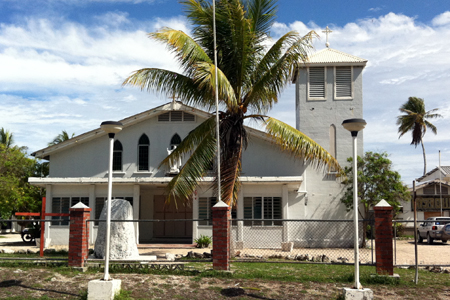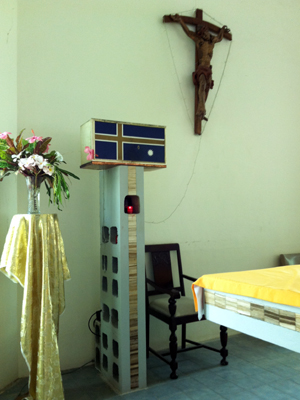| |
 |
 |
 |
| Comment on this report, or find other reports. |
 |
| Our Mystery Worshippers are volunteers who warm church pews for us around the world. If you'd like to become a Mystery Worshipper, start here. |
 |
| Find out how to reproduce this report in your church magazine or website. |
|
|
| 2218: Christ
the King, Nauru, Micronesia |
 |
 |
 |
Mystery
Worshipper: Amb3182.
The church: Christ
the King, Nauru, Micronesia.
Denomination: Roman
Catholic, Diocese
of Tarawa and Nauru, in the Archdiocese of Suva. The church
is staffed by priests from the Missionaries of the Sacred Heart,
Pacific
Union. The Catholic Church established the Vicariate Apostolic
of Gilbert Islands (now Kiribati) in 1897. The first Catholic
missionary, Father Alois Kayser MSC, arrived in 1914 and became
known as an assiduous recorder of Nauruan culture and language.
He was deported by the Japanese, along with most of the Nauruan
population, to Chuuk, where he died in 1944.
The building: Christ
the King is of the simple "hall" type of church that
is common in the South Pacific. Built in the 1920s, it is brick-built
with white stucco and has a squat tower. The interior is very
plain with no decoration aside from a set of stations of the
cross. The tabernacle veil consisted of the Nauruan flag!
The church: This
is the only Roman Catholic church in Nauru. The congregation
is made up of locals, permanent residents (mostly Filipinos)
and the occasional visitors (us). To date there have been no
successful Nauruan vocations to the priesthood, and the church
is currently served by a priest from Kiribati and a deacon from
the Marshall Islands.
The neighbourhood: Nauru
is the smallest island republic in the world (approximately
eight square miles) and the most sparsely populated state after
the Vatican. Despite its remote location in the southwestern
Pacific Ocean, it has been colonised by a series of nations
including the German Second Reich; a League of Nations trusteeship
consisting of Australia, New Zealand and the United Kingdom;
and finally Japan during the Second World War. English is an
official language, and the Australian dollar the official currency.
The church is located right above the coral reef that surrounds
the island. Is thought that the name Nauru derives from a native
word meaning "I go to the beach."
The cast: The
Revd Tatieru Eweenteang, MSC, parish priest.
The date & time: Sunday,
8 May 2011, 10.00am.
What was the name of the service?
Sunday Mass.
How full was the building?
Completely full. I sat in the sixth pew from the front behind
the choir. Church attendance is the one most important events
(if not the most important) of the week in Nauru. Just about
everything comes to a complete standstill on Sundays. Very few
shops are open and the airport is closed. Churchgoers wear their
best clothes: women often wear something white and the men wear
colourful island shirts.
Did anyone welcome you
personally?
No, but my presence was noted, judging by the number of people staring at me as I walked in.
Was your pew comfortable?
Standard timber pew – narrow seat and no padded kneelers.
How would you describe
the pre-service atmosphere?
Children and adults are all there together and there are lots
of children at church (the birth rate in Nauru is quite high)
so the atmosphere is both festive and devout.
What were the exact opening
words of the service?
"In the name of the Father, and the Son, and Holy Spirit."
What books did the congregation use during the
service?
No books were provided and the congregation sang by heart.
What musical instruments were played?
No instruments were played, but in Pacific churches the voices are so beautiful that a guitar or organ only detracts.
Did anything distract
you?
Yes, but not in a negative or annoying way. The tabernacle stand
is built of concrete Besser blocks (a common building material
in Nauru) and the fourth block from the floor was turned 90
degrees so that the resulting aperture in the concrete block
could house the sanctuary lamp. I thought this was rather clever.

Was the worship stiff-upper-lip,
happy clappy, or what?
The worship was quite similar to other masses I have attended
in the Pacific Islands. I would call it standard Catholic Pacific
if such a thing exists. There were altar girls, which suggests
a certain liberal view about the liturgy. I would say it was
relatively low-key but then it is so hot in Nauru it is too
tiring to get worked up about anything. The mass was said in
English and the hymns were all in English. The children were
very quiet during the main part of the service but were very
vocal during the singing.
Exactly how long was the
sermon?
11 minutes.
On a scale of 1-10, how
good was the preacher?
8 – Father Eweenteang's English was very good and he spoke
with a loud and clear voice, which went slightly up and down
as he talked.
In a nutshell, what was
the sermon about?
This particular Sunday was Mothers Day, so he talked about the
importance of mothers and the need to respect them and value
their contribution to society. He encouraged the mothers in
the congregation to enjoy and celebrate the day, but told them
to stay sober!
Which part of the service was like being in
heaven?
Aside from the usual in a Catholic mass (i.e., the celebration
itself) there was a beautiful moment when a group of young men
(teenagers to young adults) stood before the altar and sang
a hymn of praise to the Virgin Mary for their mothers. It was
very moving.
And which part was like being in... er... the other place?
The body odour of the men in the choir in front of us was a bit hard to take, but fortunately there was a fan above so a little breeze was a welcome relief.
What happened when you
hung around after the service looking lost?
We followed the Mystery Worshipper injunction to stand at the
back and look lost, but none of the locals came anywhere near
us. I went off to find the priest to make a donation to the
church. After I had done that and was walking back up the nave,
I spotted a gentleman whom I recognised as His Excellency the
Honourable Mr Bruce Cowled, Australian High Commissioner to
Nauru. His Excellency greeted me and we chatted briefly.
How would you describe
the after-service coffee?
There was nothing on offer and within a few minutes everyone had gone.
How would you feel about making this church your regular (where 10 = ecstatic, 0 = terminal)?
7 – I will certainly come again during my next visit to Nauru.
Did the service make you feel glad to be a
Christian?
Yes, because it reminded me of the universality of the Catholic Church and the efforts of the early missionaries who established the Catholic Church in this part of the world.
What one thing will you remember about all this in seven days' time?
The Nauruan flag veiling the tabernacle. This was the first
time I have ever seen a national flag used in this manner. |
|
|
 |
 |
 |
| We rely on voluntary donations to stay online. If you're a regular visitor to Ship of Fools, please consider supporting us. |
 |
 |
 |
| The Mystery Pilgrim |
 |
| One of our most seasoned reporters makes the Camino pilgrimage to Santiago de Compostela in Spain. Read here. |
 |
 |
 |
| London churches |
 |
| Read reports from 70 London churches, visited by a small army of Mystery Worshippers on one single Sunday. Read here. |
| |
|
|
|
|


